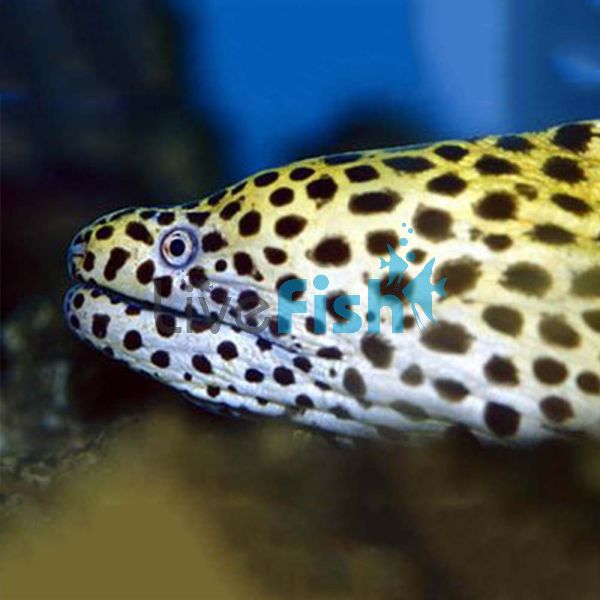Honeycomb Moray Eel - Large
The Honeycomb Moray Eel is popular in the trade due to its beautiful patterning. When placed in the right environment it will be the showpiece of an aquarium.
The Honeycomb Moray Eel is also commonly known as the Tesselate Moray. It has a striking honeycombed pattern that is formed from the black spots that cover its white body. It is one of the more aggressive Eel species that is kept in captivity. Care needs to be taken with feeding as its bite may cause a bacterial infection if left untreated. Larger specimens are ciguatoxin, - secreting a toxin through their skin.
Eel Honeycomb Moray
The Honeycomb Moray Eel is also commonly known as the Tesselate Moray. It has a striking honeycombed pattern that is formed from the black spots that cover its white body. It is one of the more aggressive Eel species that is kept in captivity. Care needs to be taken with feeding as its bite may cause a bacterial infection if left untreated. Larger specimens are ciguatoxin, - secreting a toxin through their skin. These are sizeable marine creatures that can reach 5 feet 10 inches (1.7 metres in length).
It is extremely difficult to determine the sex of this species. Breeding in captivity is difficult as the female needs to mate with several males. A single Honeycombe Moray can be enough of a handful in a home aquarium. It is also hard to replicate the conditions required for larvae.
Their natural habitat is throughout the Indo-West Pacific region. Areas include the Red Sea, East Africa, Japan. Papua New Guinea and the Great Barrier Reef. They can be found on coral reefs, inhabiting the outer slopes. Usually between 1-45 metres.
Tank Recommendations for your Honeycomb Moray Eel
A Honeycomb Moray Eel's aquarium should have a capacity of at least 180 gallons (681 litres). Dimensions need to be at least 6 feet in length and 2 feet from the front of the tank to the rear wall.
This is not a reef safe species. Honeycomb Mory Eels are aggressive feeders and will prey on the inhabitants of a reef. A suitable tank should contain rockwork with plenty of crevices for shelter. These should be big enough for the Eel to completely retreat into.
Strong filtration is recommended due to the Honeycomb Morays high bio-load. A secure cover should be placed over the top to prevent escapes. It is often a good idea to add weight to the cover to prevent the eel from pushing it open.
Suitable Tank Buddies
Honeycomb Morays can be extremely aggressive. They should only co-habit with other large aggressive species that won't be viewed as prey.
It will try to eat most types of marine life that will fit in its mouth.
Usually Compatible
Larger aggressive species of Tangs and Angelfish are suitable companions. Any fish in the tank should be too big for the eel to swallow.
Sometime Compatible
Other Moray Eels may be okay if they are of sufficient size. The Honeycomb Moray will prey on smaller eels.
Rarely Compatible
Avoid crustaceans and any fish that is small enough to be considered prey.
Feeding Your Honeycomb Moray Eel
Honeycomb Moray Eels are carnivorous. They generally eat live food or chunks of fresh meat but can be weaned onto frozen products. A suitable diet can include octopus, squid, feeder fish, krill, clams, and shrimp. This species has poor eyesight and may bite if attempting hand feeding. Feeding tongs are a recommended alternative.
| Scientific Name | Gymnothorax favagineus |
|---|---|
| Care Level | Easy |
| Common Names | Honeycomb Moray Eel, Tessalata Eel, Leopard Eel, Giraffe Eel, Blackspotted Moray Eel |
| Diet | Carnivore |
| Fish Family | Muraenidae |
| Lifespan (years) | 20 |
| Max. Length (cm) | 170 |
| Min. Tank Volume (l) | 681 Litres |
| Origin | Indo-West Pacific; Red Sea, East Africa, Japan, Papua New Guinea, the Great Barrier Reef. |
| Reef Safe | No |
| Sociability | Aggressive |
| Venomous | No |
| Water Conditions | 22 -26°C, dKH 8-12, pH 8.1-8.4, sg 1.020-1.025 |




